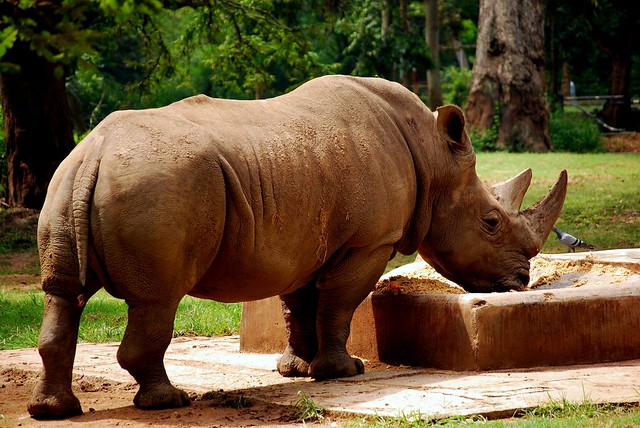
J
Javan Rhinoceros (Rhino) Animal Facts and Information - ListAnimals
The Javan rhinoceros is a types of rhinoceros local to of Southeast Asia. The Javan rhinoceros is accepted to be most immovably related to the Indian rhinoceros, the two of which simply have one horn.
Javan Rhinoceros Quick Facts
| Common Name | Javan Rhinoceros |
| Scientific Name | Rhinoceros Sondaicus |
| Group | Mammal |
| Skin Type | Leather |
| Habitat | Tropical bushland, grassland and rainforest |
| Colour | Brown, Grey, Black |
| Size (L) | 3.1m- 3.2m (10ft - 10.5ft) |
| Weight | 900kg - 2,300kg (2,000lbs - 5,100lbs) |
| Top Speed | 42km/h (30mph) |
| Diet | Herbivore |
| Prey | Grass, Fruit, Berries, Leaves |
| Predators | Human, Wild cats |
| Lifestyle | Solitary |
| Lifespan | 30-45 years |
| Favourite Food | Grass |
Starting at 2019, its evaluated only 72 Javan rhinos get by in a solitary national park named Ujung Kulon on the Indonesian island of Java's western-most tip. Be that as it may, with no poaching of the species announced in over 25 years at Ujung Kulon, there's promise for the species' endurance.
Mind blowing Javan Rhino Facts!
- The Javan rhinoceros once wandered from India, to Vietnam, and south to the islands of Indonesia. The last territory Javan rhino was poached in 2010, leaving the subspecies of terrain Javan rhinos wiped out.
- Female Javan rhinos frequently come up short on a horn or have a little "stub."
- Today, the Javan rhino is found in just a solitary national park that sits 37 miles (60 km) from a functioning fountain of liquid magma that is emitted as of late as December, 2019.
Javan Rhino Appearance
The Javan rhino is littler than the Indian rhinoceros, gauging 900 to 2,300 kg (2,000 to 5,100 lbs). Its length extends 3.1 to 3.2 m (10 to 10.5 ft).The Javan rhino intently looks like Indian rhinos. The two species have a solitary horn, however female Javan rhinos regularly do not have a horn or have a little "stub" on their nose. Furthermore, the Javan rhino's skin folds aren't as articulated as the Indian rhino. This gives the species to a lesser extent a look of having "body protective layer."
Because of the outrageous uncommonness of Javan rhinos, they've been considered the in particular rhino species. Today, hardly any photos are taken of Javan rhinos, with most examination originating from camera traps in the thick timberlands it occupies in Ujung Kulon National Park.
Javan Rhino Habitat
The Javan Rhino principally occupies thick marsh downpour timberlands, tall grass and reed beds that are abundant with streams, enormous floodplains, or wet zones with many mud flounders. The extent of Javan rhinoceros once stretched out from Bengal, through Southeast Asia and down to Sumatra yet today, the Javan rhinoceros is simply found on the island of Java.Javan Rhino Population
The population of Javan rhinos was assessed at 72 people by the International Rhino Foundation in 2019.While this population makes the Javan rhino one of the most fundamentally imperiled warm blooded creatures on Earth, it has been steady for over 30 years and their population has expanded from an expected 50 people over the previous decade.
Javan Rhinoceros Scientific Name
The scientific name for the Javan rhinoceros will be Rhinoceros sondaicus. Alongside the Indian rhinoceros, the Javan rhino is in the class Rhinoceros, which is Greek for 'nose' and 'horn' and includes the two types of one-horned rhinos. Sondaicus alludes to 'Sunda,' a name for the Southeastern Asian where Javan rhinos verifiably lived.Javan Rhino Diet
The Javan rhino is a herbivore that peruses across bushes, brambles, and saplings. Javan rhinos peruse the thickly vegetated sub-tropical backwoods for leaves, blossoms, buds, organic products, berries and roots which they uncover from the beginning their horns.Because of Javan rhinos being confined to a little habitat, it's difficult to tell how changed their diet was over their verifiable range. With Javan rhino populations having gone right to the thick meadows of India, it's reasonable the species once munched also.
Javan Rhino Predators
The Javan rhino faces barely any predators in nature. Javan tigers existed in Ujung Kulon until the 1960s, yet have been pronounced wiped out. A little population of Javan panthers get by in Ujung Kulon and could go after rhino calves and more vulnerable people.With no human poaching detailed in the rhino's enduring habitat in the previous 25 years, its most prominent danger today is an absence of hereditary assorted variety that undermines reproducing numbers.
Javan Rhino Reproduction and Life Cycles
With a very little population and long incubation periods, the introduction of any Javan rhino is firmly observed. In December 2019, four new calves were spotted, expanding the population to an expected 72 rhinos.Like all rhino species, the Javan rhino has a long growth period which makes repopulating testing. Since no Javan rhinos are held in bondage, their development period isn't exactly known. Be that as it may, its accepted to be approximately 15 to 16 months.



0 Comments:
Please do not enter any spam link in the comment box.